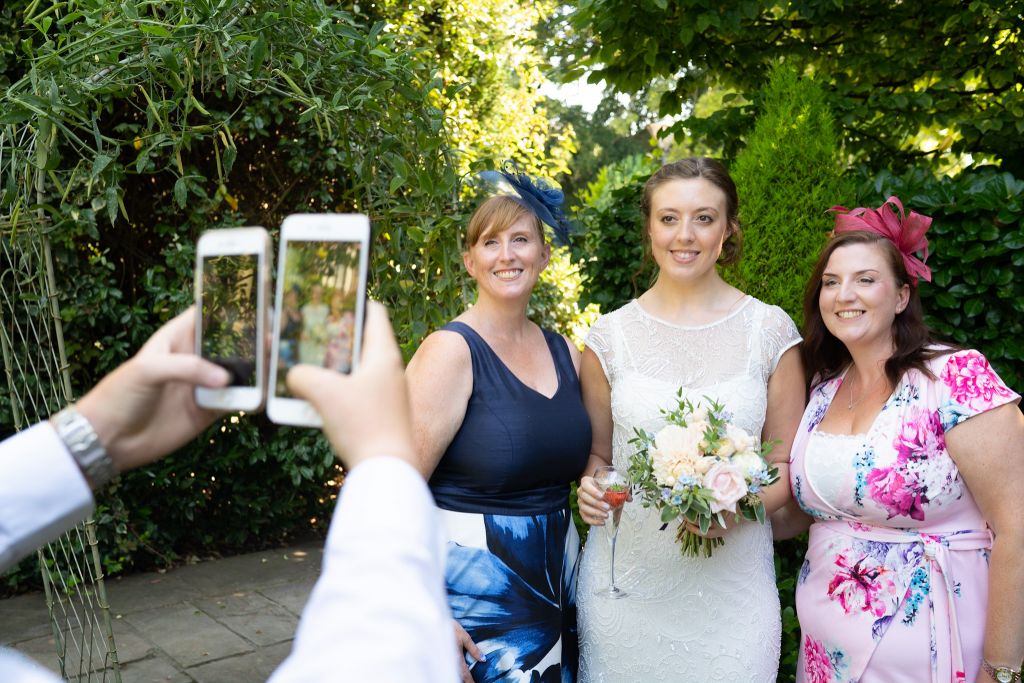Using a phone to record a wedding.
Modern phones have high quality cameras with many features that are similar to cameras used by videographers. They generally have a wide angle lens that will capture a lot of light.
For most weddings in well lit venues in the middle of the day this should work pretty well. I would avoid using the zoom function as this will degrade the quality of the image. This won’t be so noticeable on a small screen but will be very evident if viewed on a large screen.
Where the camera lens falls down is that the lens itself is tiny by comparison so doesn’t capture much light in low light situations. A mirrorless camera with a prime lens capable of a wide aperture of F2.8 or wider will outperform most phone cameras just because of optics and the width of the glass being able to let in more light.
Most camera phones have face recognition so should focus well on the main subjects, the bride and groom.
The biggest thing to avoid doing is to hold the phone in portrait mode (like in the image shown here). This will look fine on a phone held in portrait mode but on any other screen such as a laptop or desktop computer the image will be cut off at the sides. You see this happen all the time on the news when people film things happening on the street without thinking how that’s going to look on TV. Hold the phone in landscape mode whilst you film.
Storage.
My iPhone has 128GB of storage and about half of that storage is free so that should be more than adequate. I typically have two 64GB cards loaded into my Lumix S5 and they rarely get filled up.
Battery life.
I always carry spare batteries for my cameras and charge up batteries when one is swapped out. This is a bit tricky with a phone. You could use two phones I suppose or when you take a break you could charge up your phone again from mains or a portable charger.
Audio.
I have not tested this out but I suspect that the microphones on phones are not directional or as high quality as some camera microphones. Your best option will be to get as close as you possibly can to the subject doing the talking or record audio on another device. During the speeches a second phone lying on the top table in front of the speakers would work I think.
Editing and video production
I’ve seen many people filming on phones at weddings but I’ve yet to learn what they did when they got home with the video clips.
If it’s the odd short clip then obviously that can easily be shared on social media. If you are filming the whole wedding with the intention of bringing it all together as one continuous film, having first edited out any errors, shortened some of the clips that are too long and possibly added music tracks then this requires some upfront planning and research into how this can be achieved.
Using a video camera that records to an SD card makes the whole process much easier. I can then load all my clips onto an external SSD drive attached to my Mac. It can take an hour or more for me to load all the clips into Final Cut Pro, a couple of days to edit the footage then another couple of hours to compress the final video and load it onto a USB stick for delivery to my client. How that process would look if I was trying to do it all on a phone I don’t know but I suspect that it would be long winded.
If I was in that position I think I would find a way to get the clips off my phone onto an SD card (I know there are adapters that can attach an SD card to a phone). I would then proceed with my normal editing process on a Mac.
Another option on an iPhone might be to load clips into iMovie from where they can be shared to Dropbox but I suspect that large clips will take a while to process by this method even on a modern iPhone. From Dropbox it would be possible to import media into a Final Cut Pro project for further editing.
The main point of this rambling piece is that it all involves some thought, planning and testing of the approach well before you agree to film a whole event on your phone.
If I was sat in a wedding and the videographer didn’t show up and I was asked if I could film it instead then I would give it a go, on my phone if I had to, but I would probably have a small camera with me anyway. The Sony RX100 is not much bigger than a phone and can do a reasonable job filming a wedding and writes to an SD card for easy editing/video production. So if only for the editing and video production process using a purpose built camera is preferable.
Having said that there is a saying amongst photographers and videographers that says ‘the best camera you have is the one you have with you’. You use what you can to get what you need.
Martin Waring - Wedding Videography York
